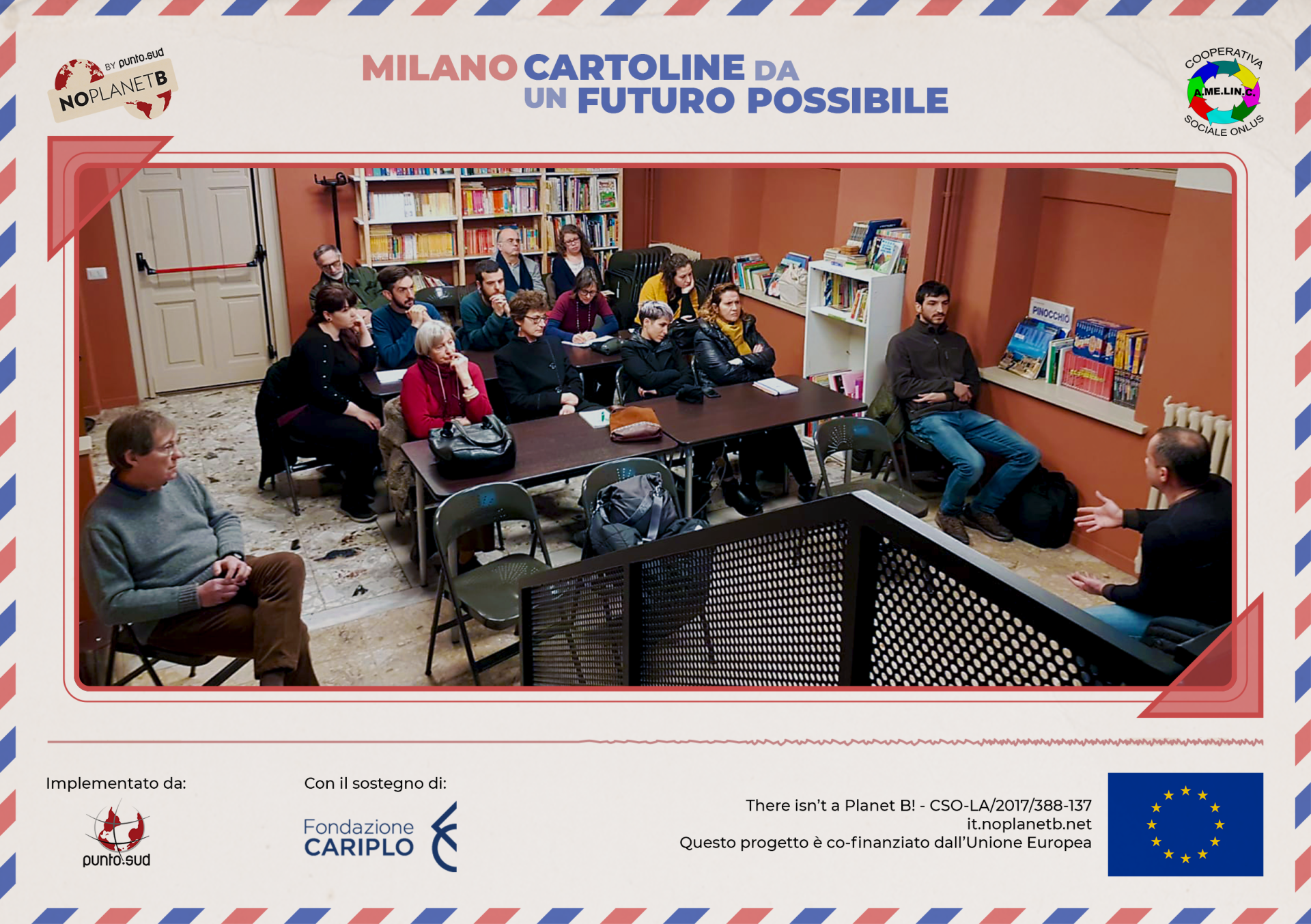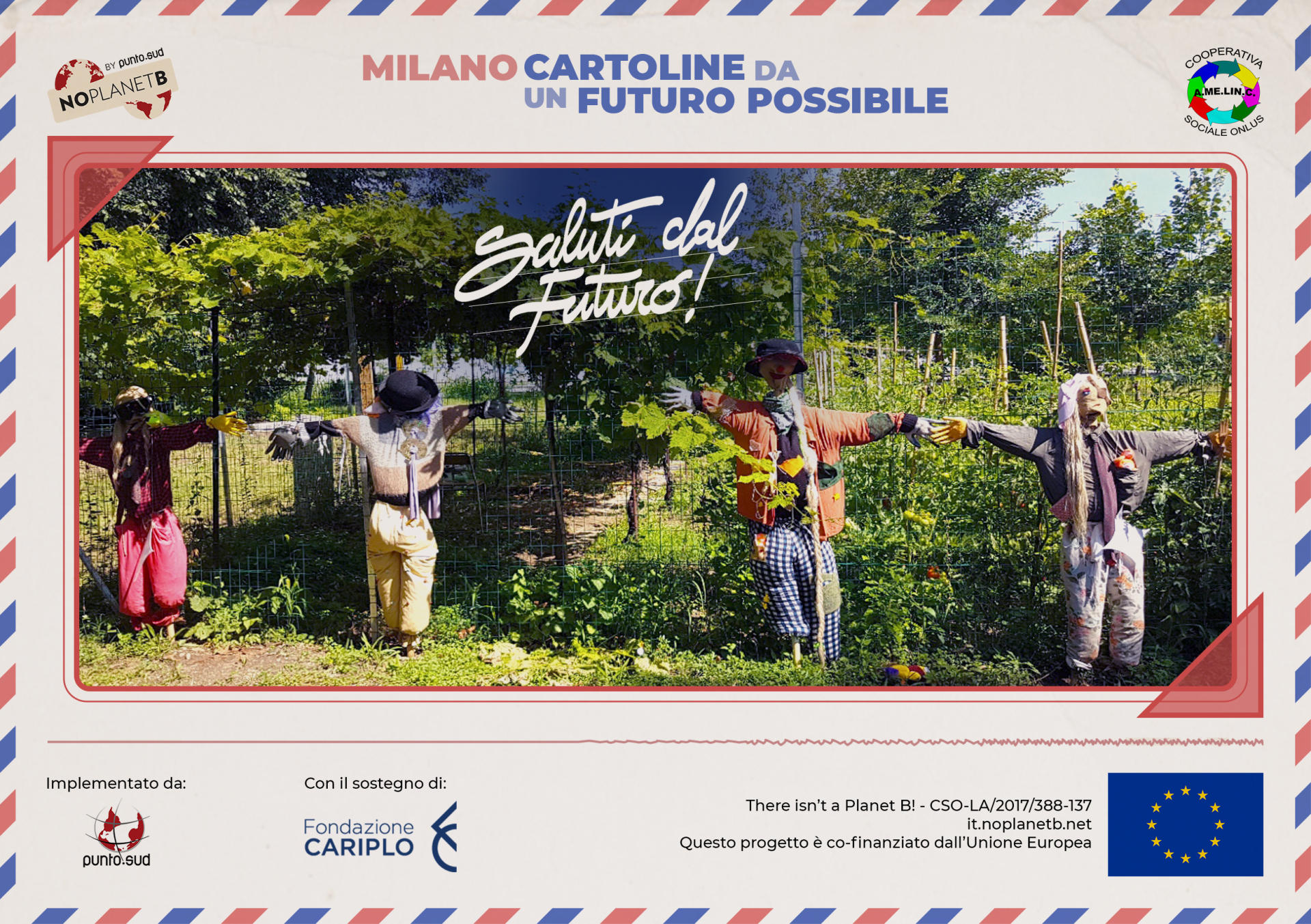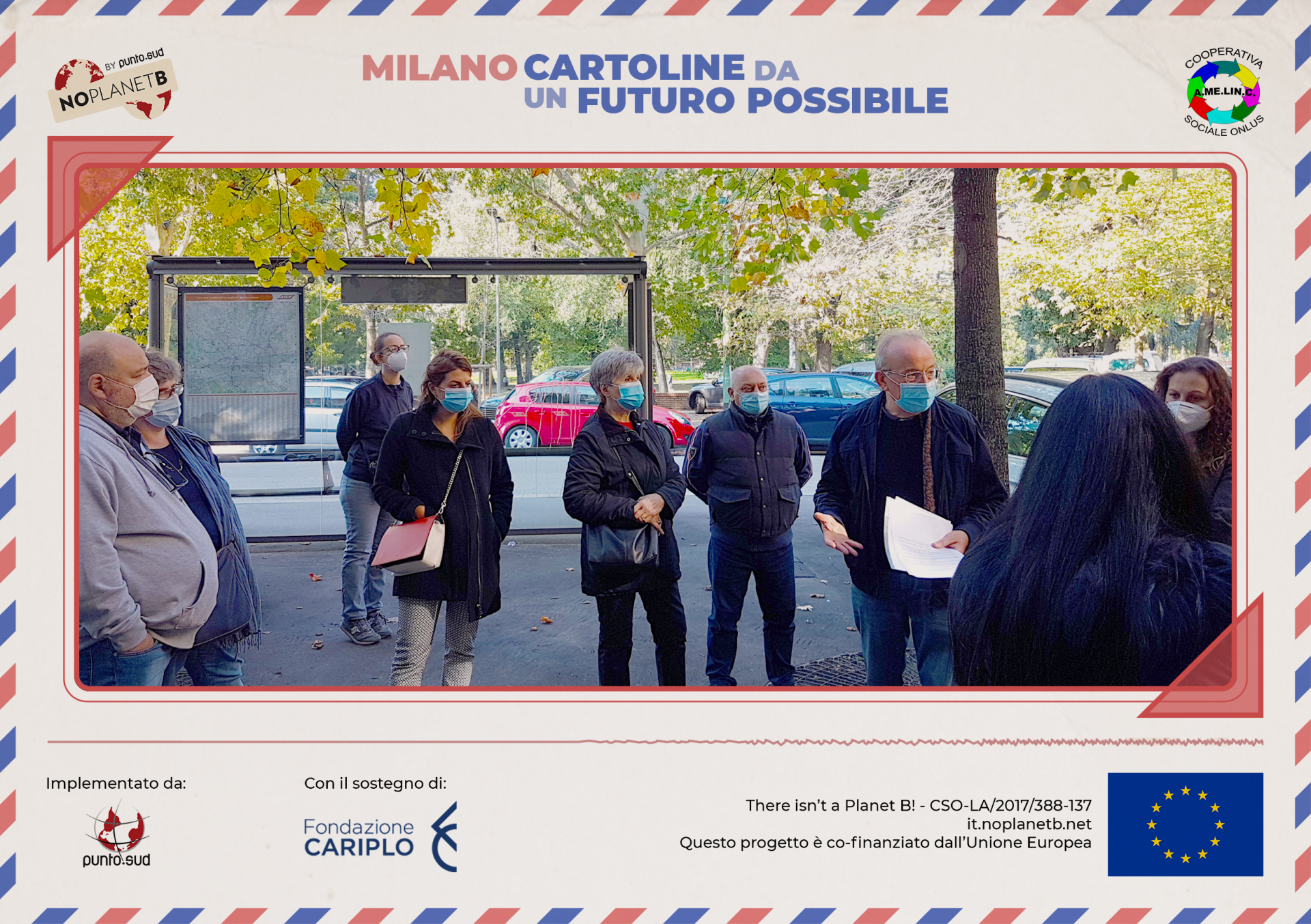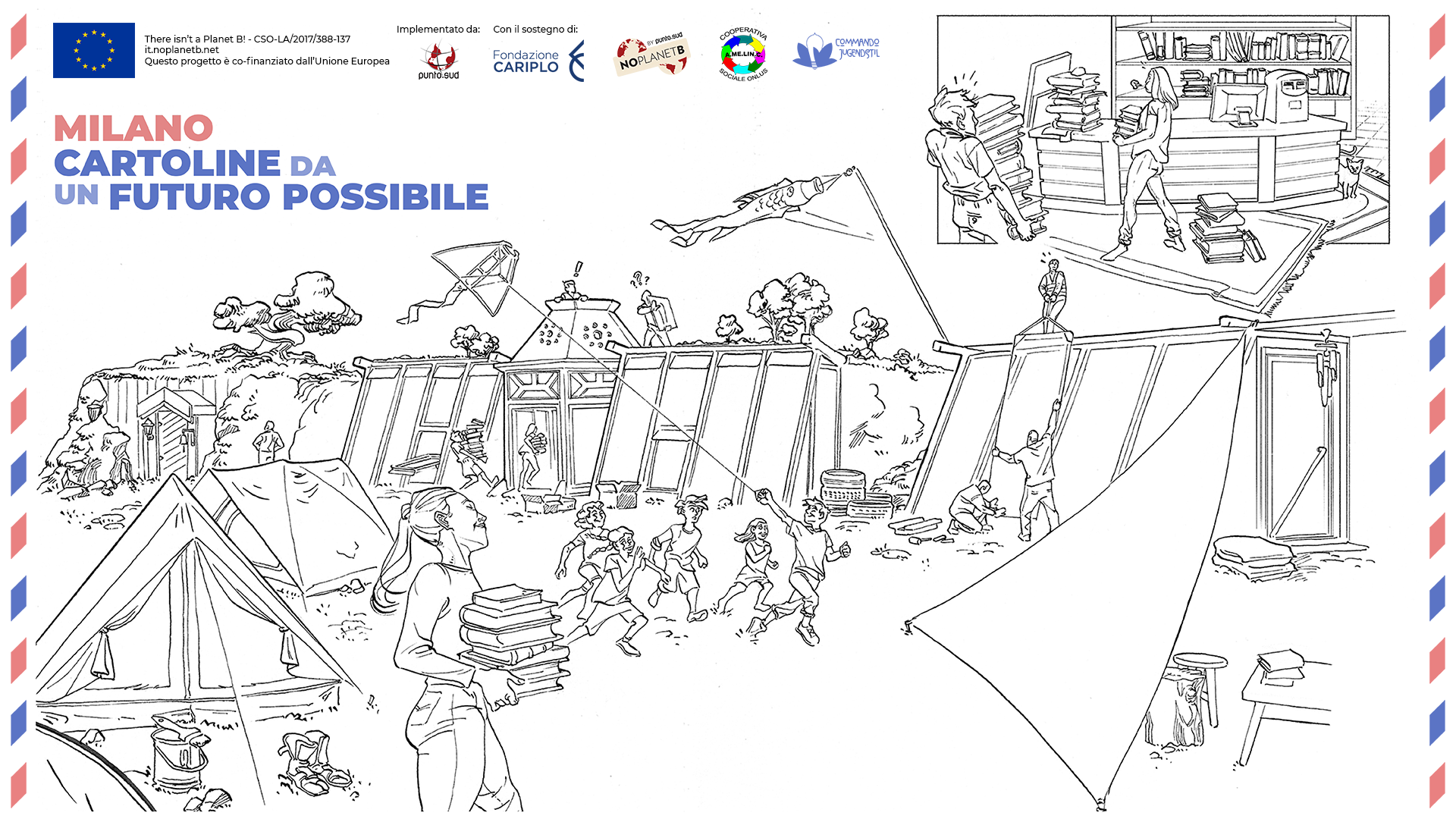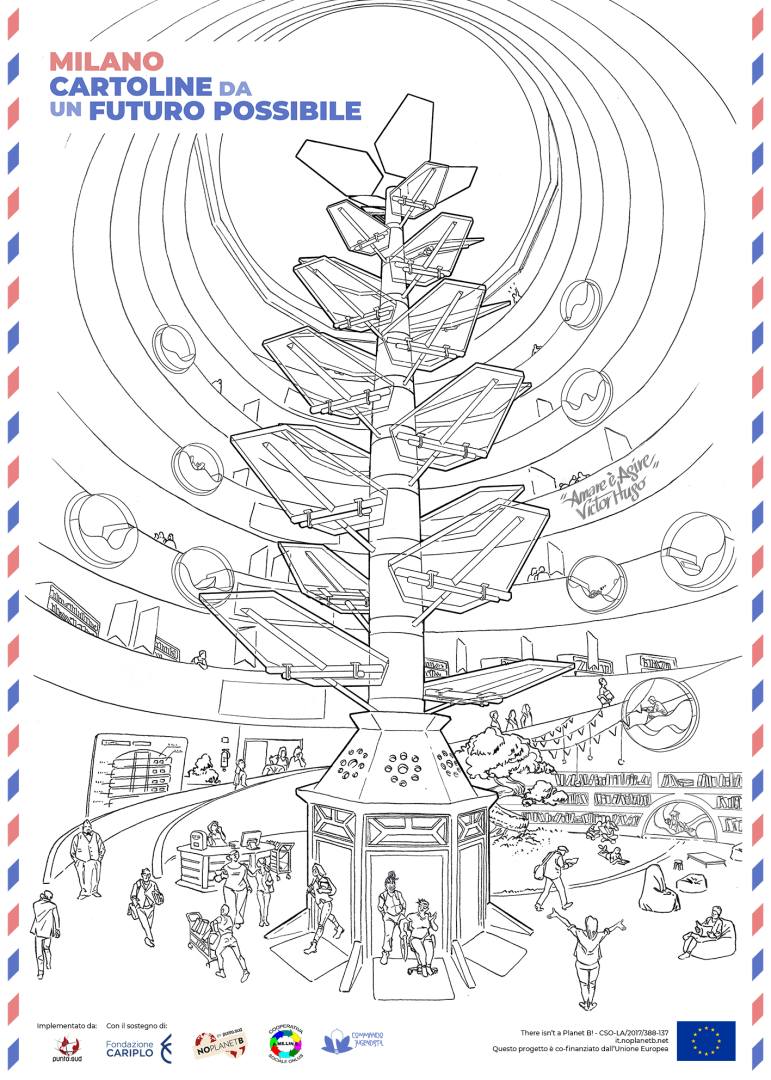Milano, Postcards from a Possible Future
Basic information
Project Title
Full project title
Category
Project Description
Milano, Postcards from a Possible Future is a project where the participants have learned sustainability, have started implementing it in their neighbourhoods, and have imagined their sustainable future, all to give shape to the Milano of tomorrow.
Knowing that if you can't imagine a sustainable future, then you can't start to build it, we devised a project that could ignite the spark in the mind of the participants, by giving them knowledge and helping them imagine and implement their future.
Geographical Scope
Project Region
Urban or rural issues
Physical or other transformations
EU Programme or fund
Which funds
Description of the project
Summary
This project was meant to help citizens of two underserved neighbourhoods in Milano redesign their neighbourhood to improve living standards, social inclusion and cohesion, and to tackle the challenges of the climate crisis, connecting local conflicts in the management of the commons and local issues with wider processes. These are the communities where a Just Transition would bring more benefits.
This has been obtained through a series of (in)formative sessions, focus groups and workshops, delivered in collaboration with local and renowned experts, local schools and local neighbourhood committees. These initiatives have allowed citizens to take an active role in a collective and democratic process to redesign the local environment. Throughout the project, citizens have been encouraged not only to find practical short- and medium-term solutions to increase the sustainability and liveability of their environment, but also to make use of narrative and artistic tools to illustrate their long-term vision of a post-transition neighbourhood, identifying long-term projects to realise it.
The main outputs of the project have been:
- A series of meetings with experts in various field of sustainability, from energy production to recycling, some of which were held in local schools.
- A series of online bite-sized lessons and resources (slides, podcasts, etc), that anyone can access to build their sustainability project. They address a number of topics, from urban regeneration to crowdfunding and grant writing, to establishing and taking care of a urban garden.
- The creation of a didactic urban garden, built in the middle of the city with the intent of reconnecting young and old citizens with the production of food and a more ethical and sustainable relationship with nature.
- A dedicated digital platform that collects community generated local visions for the future, enabling residents to imagine radical long term solutions to the sustainability issues of their community.
Key objectives for sustainability
Our main objective was to give the participants the tools that they needed to start implementing sustainable solutions immediately and, by doing so, help them realize that sustainability isn't - or doesn't have to be - the "élite" choice.
We tried to achieve this in a number of ways:
- We transmitted knowledge about sustainable technologies and good practices, telling the participants what has been done, what is being done and what could be done in the future. We connected students and people from marginalized communities with world renowned experts, who could expand their horizons and give a sustainable answer to their daily, practical needs.
- We kept reduce, reuse and recycle at the centre of our project. For example we used food that was going to be wasted to create the compost for our didactic urban garden, for which we also built structures with recycled wood.
- We tried to pass sustainability as a philosophy, a way of looking at the world, in everyone of our workshops. For example, we have been looking into a sustainable use of the public space in our Urban Regeneration Laboratory.
- We built scenarios of the possible sustainable future of the neighbourhoods, to give the participants an horizon to aspire to and to give them a picture of how their choices and behaviour of today could translate in the society of tomorrow.
In all of our actions we used the needs of the participants as our set of lenses, to make sure that sustainability could be a choice tailored for their context: local solutions for a global challenge. Rather than trying to impose a top-down plan, we built the city with the people that will eventually use and live it, and this approach was probably one of the things that contributed the most to the success of our project.
Key objectives for aesthetics and quality
Our main objective in terms of quality of experience and aesthetics was to help the participants turn non-places and abandoned areas of their neighbourhoods into landmarks where people could find and share common values. We tried to do this not just in practical, immediate terms, but also with an eye to the future, helping citizens to imagine and build their own narratives of the sustainable future, from the ground up.
We turned our objective in reality by:
- Helping to transform an abandoned plot of land into a didactic urban garden. The plot was in a bad state of neglect, sometimes used by drug dealers and thieves to hide or throw away unwanted items. We provided the tools needed and we offered knowledge by connecting the participants with experts. The result is a fertile garden that provided food for families during - for example - the pandemic, and that is being used by nearby schools to reconnect children with the production of vegetables and the cycle of nature.
- Designing and creating a web platform to showcase the stories of our sustainable present and scenarios of possible futures. As a base, we used the Omeka technology, an open-source web publishing platform. On the website you can read about the urban garden, but also about a possible new european library, for example. We did this with the specific intent of giving anyone the tools that they may need to replicate our project somewhere else: to diffuse knowledge and good practices. To increase the reach of these ideas, we printed posters with a QR code that pointed to the platform, and we affixed them throughout the city, reaching a good numbers of users from different areas as well.
What makes this project unique is the constant dialogue between the sustainable initiatives that we created today and the shape of the city that we imagined for tomorrow: one informs the other, in what we believe to be a virtuous cycle, where imagination constantly pushes the boundaries of what is possible.
Key objectives for inclusion
Our project was conceived and designed to be inclusive. We have been aiming at involving every citizen in the two neighbourhoods where we operated since the very inception of it. In fact, we:
- Invited students and marginalized communities to participate. Our project was based in the Molise-Calvairate-Ponti and Ponte Lambro neighbourhoods of the city of Milano, where the population is largely composed by immigrants, elderly and other categories at risk of social exclusion. By locating our project there, where the social cooperative A.ME.LIN.C. has been working for years, we wanted to include people that normally aren't included in the sustainability discourse, because they are the ones that would benefit the most from the application of sustainable principles.
- Co-designed the program of our labs with the people that would take them. We made preliminary meetings with the participants to understand what their needs were, and then we devised a plan for our laboratories that could help us make the right match between the knowledge that we were offering through our experts, and the citizens that would benefit the most from it.
- Designed the labs to be a mixture of virtual and in-person meetings, to avoid excluding people who didn't have access to internet. This way, anyone could access the knowledge we were offering.
- Designed our scenarios of the future starting from the inputs that we received from the participants. This was to make sure that their visions and their plan for the future would be represented.
We spent our efforts making the project accessible to everyone, regardless of their background or needs, in any way that we could.
Results in relation to category
We wanted to work in marginalized areas of the city and with people that normally thinks that sustainability is a choice out of their reach because they are the contexts that could benefit the most from the application of a sustainable approach. In particular, this has been evident for us in two main ways:
- Our present. Where there was an abandoned plot of land we helped create a didactic urban garden. We provided the tools, we diffused the knowledge, we kickstarted a community that is still going strong. For example, the vegetables grown in that urban garden have helped people in need during the Covid-19 pandemic. We designed the garden with the people that would use it. We told the participants how to pass the knowledge to kids, so they started inviting young students from nearby schools. We created the compost with them, telling them how to do it. Hopefully, one day, they will find anothe patch of land and replicate the experiment.
- Our future. We helped the participants to imagine how the places that need sustainability the most could look like in 20, 30 years. In doing so, we gave them the chance to take ownership of their neighbourhood, and form a plan to create its future shape. We collected inputs and inspirations from all the participants to the laboratories and workshops, and crystallized their desires in the visions that we published on the dedicated platform.
While the project was ongoing, we witnessed the birth of a community: people would start to see their neighbourhood like their own space, rather than a dormitory or just a passing place. This, we believe, is one of the most important steps in the creation of sustainability: a community that feels a sense of belonging.
How Citizens benefit
As said before, we provided a framework that the participants could adapt to their needs, building local sustainable responses. During the concept phase, the help of the experts from social cooperative A.ME.LIN.C. has been invaluable in defining a boundary of needs that could inform what actions we would need to take later on. Our framework included: Compost lab, Urban Garden workshops, Conflict Management sessions, Wood Recycling lab, Urban Regeneration lab, Crowdfunding lab, Solar Energy lab, Storytelling workshops.
- Citizens were involved from day one in meetings were they could tell us what their needs were.
- We arranged our framework in a way that the participants were divided in geographic and/or interest groups, and so they could make the most out of it.
- We built the agenda together with the participants, so they wouldn't risk of missing an appointment.
- We followed all the events, being the links between the experts and the participants.
- We listened to their inputs and suggestions, gave them shape and published the visions in a space where they could see them.
- We opened the results of the project to every citizen of Milano, hoping that they would be inspired by it.
Physical or other transformations
Innovative character
The most innovative traits of our project can be resumed in two main branches:
- We didn't stop at the theory. We experienced sustainability projects that were very focused on a particular aspect, and they didn't describe the whole picture, not to mention the fact that they purely theoretical. We wanted to subvert this tendency. For everyone of the aspects of sustainability that we touched in our project, we decided to give the theoretical tools first, but then we also made the effort of applying those tools in practice. When we were talking about sustainable food production, then we went in the didactic urban garden and we've show to the participants how to do it, even if it was just on a micro level. When we explained what exactly solar energy is, then we've also demonstrated how to plan, buy and install solar panels. And the same strategy was used for every subject that we included in our framework.
- We imagined sustainable futures. One of the things that we wanted to focus on was the possibility of giving to the participants an outlook on their Just Transition future: what it could look and feel like and what would it mean to live there. To do this we exploited our experience as solarpunk authors - we published stories, essays and illustrations all over the world - and we applied co-design methods like backcasting to successfully envision our postcards from the possible future. To boost the imagination of the participants, we also made available all the knowledge about the subject that we could, may it be on the more pioneering side - we have shown them first hand new technologies in the field of solar energy - or may it be more on the practical and "down-to-earth" side - we hosted talks and demonstrations of experts that showed the best new techniques to design a urban garden.
Learning transferred to other parties
There is a lot of potential for scalability in this project. So much, that we already applied it in two new contexts, with some variations depending on the new situations.
For example, we obtained new funding to evolve and expand the project in Milano, that now includes three neighbourhoods and another social cooperative, but keeps its fundamental drive: help citizens living in marginalized urban areas to implement sustainability. Gratosoglio, the new neighbourhood, has very similar background to the areas where we have already implemented the previous project and, from what we have already been doing and witnessing so far, seems to be promising in terms of the creativity and willingness of the participants. This new project will end with 2022 and one of the outcomes will be an animated docu-fiction.
We also received funding from the National Lottery Community Fund via Transition Bounce Forward for a project in Reading (UK), called The Town That Could Be - a time travel journal from Reading 2045, that shared the same principles and methodology of Milano, Postcards from a Possible Future, but it was structured in a slightly different way. In Reading, we organized virtual meetings where everybody could come and talk and learn about a specific subject. We also went to local events, where we distributed and collected postcards with which people could imagine to be in 2045 and write what a town that passed through the Just Transition could look and feel like. We then gathered all the inputs from the meetings and the postcards that we received, and created a fiction, a story where 6 characters explore the Reading of the future and take notes of their experience. We then printed this time travel journal and gave it back to the participants.
So, as you can see, different outcomes, but same principles: diffuse knowledge, then help citizens envision their sustainable future, implementing it where already possible.

